Project Management Report
VerifiedAdded on 2023/03/29
|8
|1567
|174
AI Summary
This report discusses the challenges and strategies in project management for a bearing manufacturing process. It covers aspects such as schedule, cost, customer satisfaction, quality, and stakeholder involvement.
Contribute Materials
Your contribution can guide someone’s learning journey. Share your
documents today.
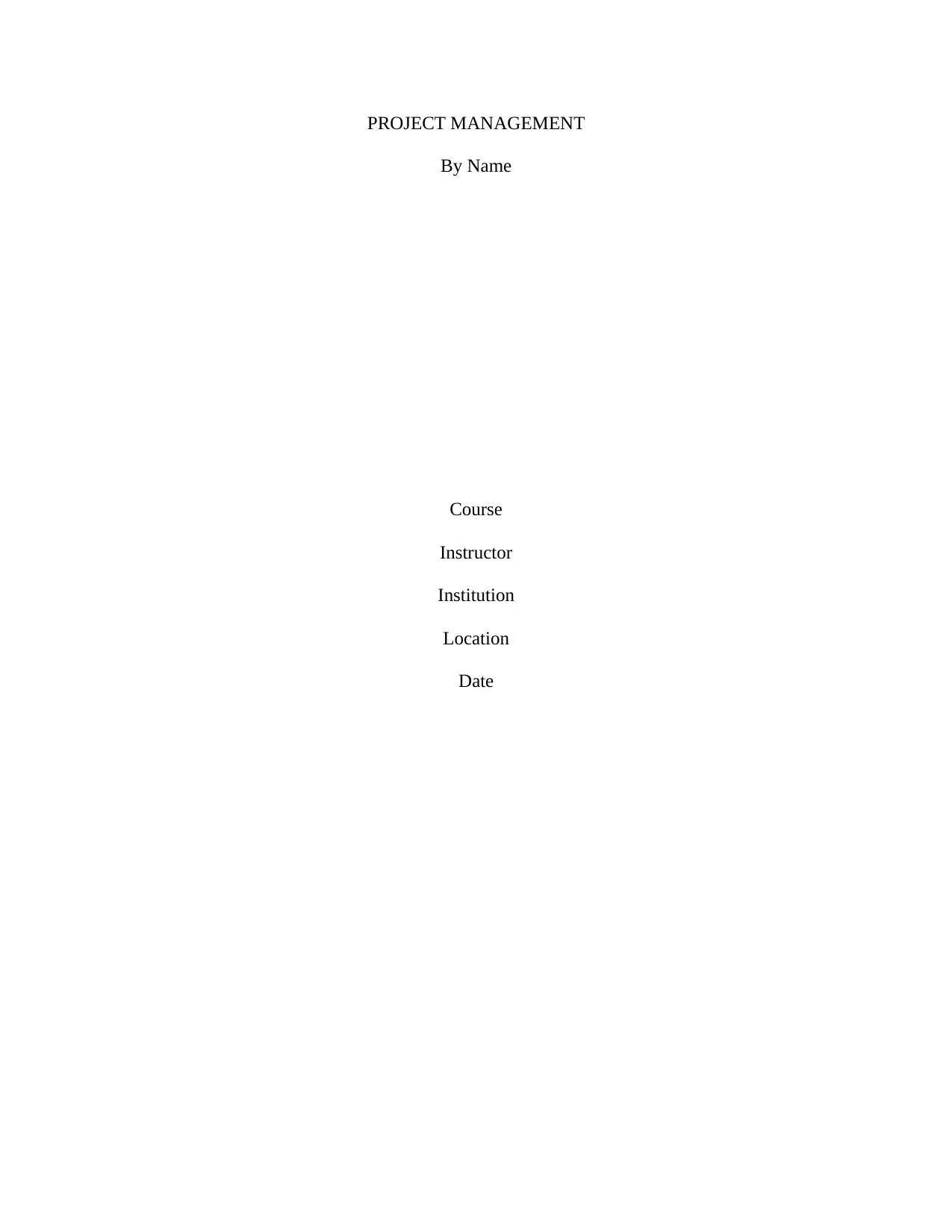
PROJECT MANAGEMENT
By Name
Course
Instructor
Institution
Location
Date
By Name
Course
Instructor
Institution
Location
Date
Secure Best Marks with AI Grader
Need help grading? Try our AI Grader for instant feedback on your assignments.
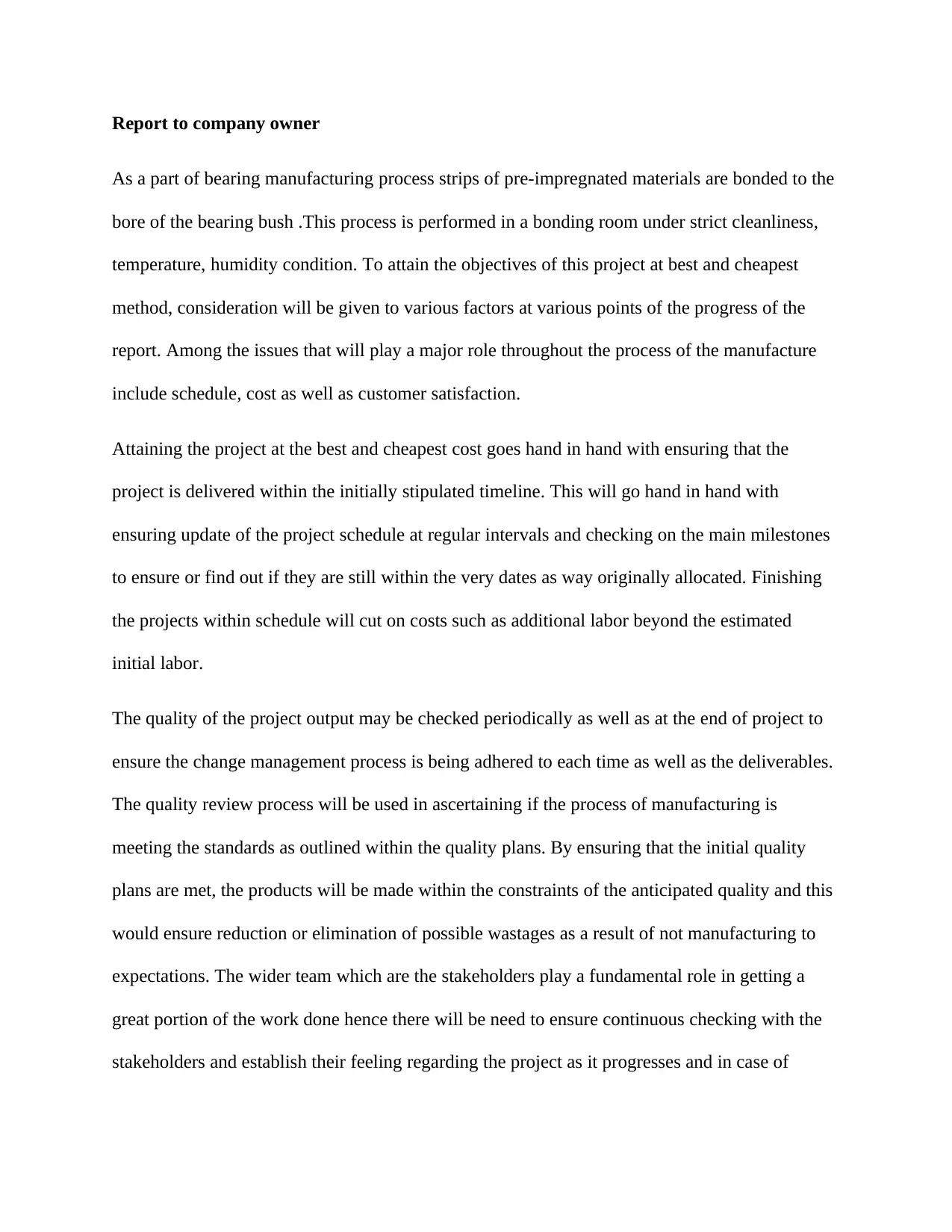
Report to company owner
As a part of bearing manufacturing process strips of pre-impregnated materials are bonded to the
bore of the bearing bush .This process is performed in a bonding room under strict cleanliness,
temperature, humidity condition. To attain the objectives of this project at best and cheapest
method, consideration will be given to various factors at various points of the progress of the
report. Among the issues that will play a major role throughout the process of the manufacture
include schedule, cost as well as customer satisfaction.
Attaining the project at the best and cheapest cost goes hand in hand with ensuring that the
project is delivered within the initially stipulated timeline. This will go hand in hand with
ensuring update of the project schedule at regular intervals and checking on the main milestones
to ensure or find out if they are still within the very dates as way originally allocated. Finishing
the projects within schedule will cut on costs such as additional labor beyond the estimated
initial labor.
The quality of the project output may be checked periodically as well as at the end of project to
ensure the change management process is being adhered to each time as well as the deliverables.
The quality review process will be used in ascertaining if the process of manufacturing is
meeting the standards as outlined within the quality plans. By ensuring that the initial quality
plans are met, the products will be made within the constraints of the anticipated quality and this
would ensure reduction or elimination of possible wastages as a result of not manufacturing to
expectations. The wider team which are the stakeholders play a fundamental role in getting a
great portion of the work done hence there will be need to ensure continuous checking with the
stakeholders and establish their feeling regarding the project as it progresses and in case of
As a part of bearing manufacturing process strips of pre-impregnated materials are bonded to the
bore of the bearing bush .This process is performed in a bonding room under strict cleanliness,
temperature, humidity condition. To attain the objectives of this project at best and cheapest
method, consideration will be given to various factors at various points of the progress of the
report. Among the issues that will play a major role throughout the process of the manufacture
include schedule, cost as well as customer satisfaction.
Attaining the project at the best and cheapest cost goes hand in hand with ensuring that the
project is delivered within the initially stipulated timeline. This will go hand in hand with
ensuring update of the project schedule at regular intervals and checking on the main milestones
to ensure or find out if they are still within the very dates as way originally allocated. Finishing
the projects within schedule will cut on costs such as additional labor beyond the estimated
initial labor.
The quality of the project output may be checked periodically as well as at the end of project to
ensure the change management process is being adhered to each time as well as the deliverables.
The quality review process will be used in ascertaining if the process of manufacturing is
meeting the standards as outlined within the quality plans. By ensuring that the initial quality
plans are met, the products will be made within the constraints of the anticipated quality and this
would ensure reduction or elimination of possible wastages as a result of not manufacturing to
expectations. The wider team which are the stakeholders play a fundamental role in getting a
great portion of the work done hence there will be need to ensure continuous checking with the
stakeholders and establish their feeling regarding the project as it progresses and in case of
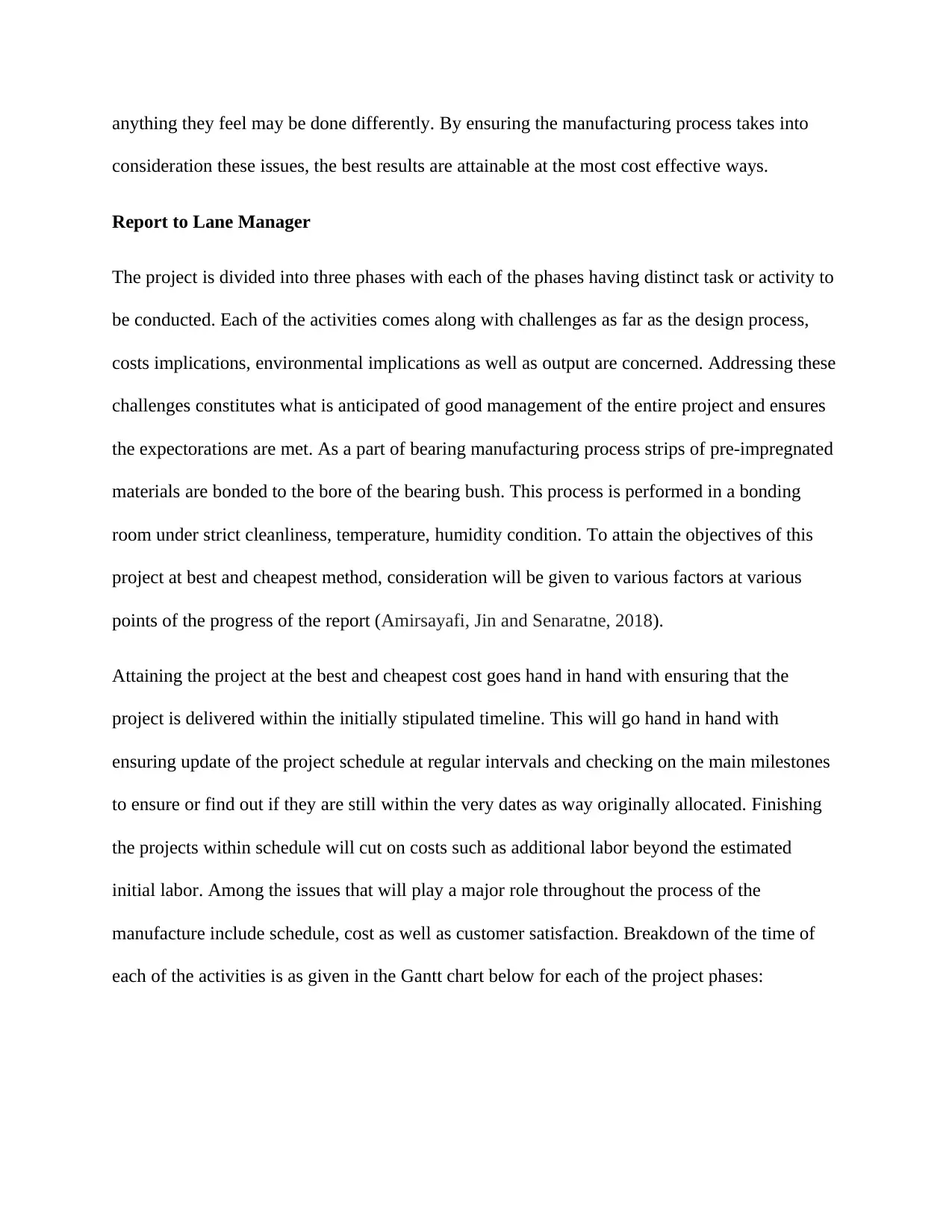
anything they feel may be done differently. By ensuring the manufacturing process takes into
consideration these issues, the best results are attainable at the most cost effective ways.
Report to Lane Manager
The project is divided into three phases with each of the phases having distinct task or activity to
be conducted. Each of the activities comes along with challenges as far as the design process,
costs implications, environmental implications as well as output are concerned. Addressing these
challenges constitutes what is anticipated of good management of the entire project and ensures
the expectorations are met. As a part of bearing manufacturing process strips of pre-impregnated
materials are bonded to the bore of the bearing bush. This process is performed in a bonding
room under strict cleanliness, temperature, humidity condition. To attain the objectives of this
project at best and cheapest method, consideration will be given to various factors at various
points of the progress of the report (Amirsayafi, Jin and Senaratne, 2018).
Attaining the project at the best and cheapest cost goes hand in hand with ensuring that the
project is delivered within the initially stipulated timeline. This will go hand in hand with
ensuring update of the project schedule at regular intervals and checking on the main milestones
to ensure or find out if they are still within the very dates as way originally allocated. Finishing
the projects within schedule will cut on costs such as additional labor beyond the estimated
initial labor. Among the issues that will play a major role throughout the process of the
manufacture include schedule, cost as well as customer satisfaction. Breakdown of the time of
each of the activities is as given in the Gantt chart below for each of the project phases:
consideration these issues, the best results are attainable at the most cost effective ways.
Report to Lane Manager
The project is divided into three phases with each of the phases having distinct task or activity to
be conducted. Each of the activities comes along with challenges as far as the design process,
costs implications, environmental implications as well as output are concerned. Addressing these
challenges constitutes what is anticipated of good management of the entire project and ensures
the expectorations are met. As a part of bearing manufacturing process strips of pre-impregnated
materials are bonded to the bore of the bearing bush. This process is performed in a bonding
room under strict cleanliness, temperature, humidity condition. To attain the objectives of this
project at best and cheapest method, consideration will be given to various factors at various
points of the progress of the report (Amirsayafi, Jin and Senaratne, 2018).
Attaining the project at the best and cheapest cost goes hand in hand with ensuring that the
project is delivered within the initially stipulated timeline. This will go hand in hand with
ensuring update of the project schedule at regular intervals and checking on the main milestones
to ensure or find out if they are still within the very dates as way originally allocated. Finishing
the projects within schedule will cut on costs such as additional labor beyond the estimated
initial labor. Among the issues that will play a major role throughout the process of the
manufacture include schedule, cost as well as customer satisfaction. Breakdown of the time of
each of the activities is as given in the Gantt chart below for each of the project phases:
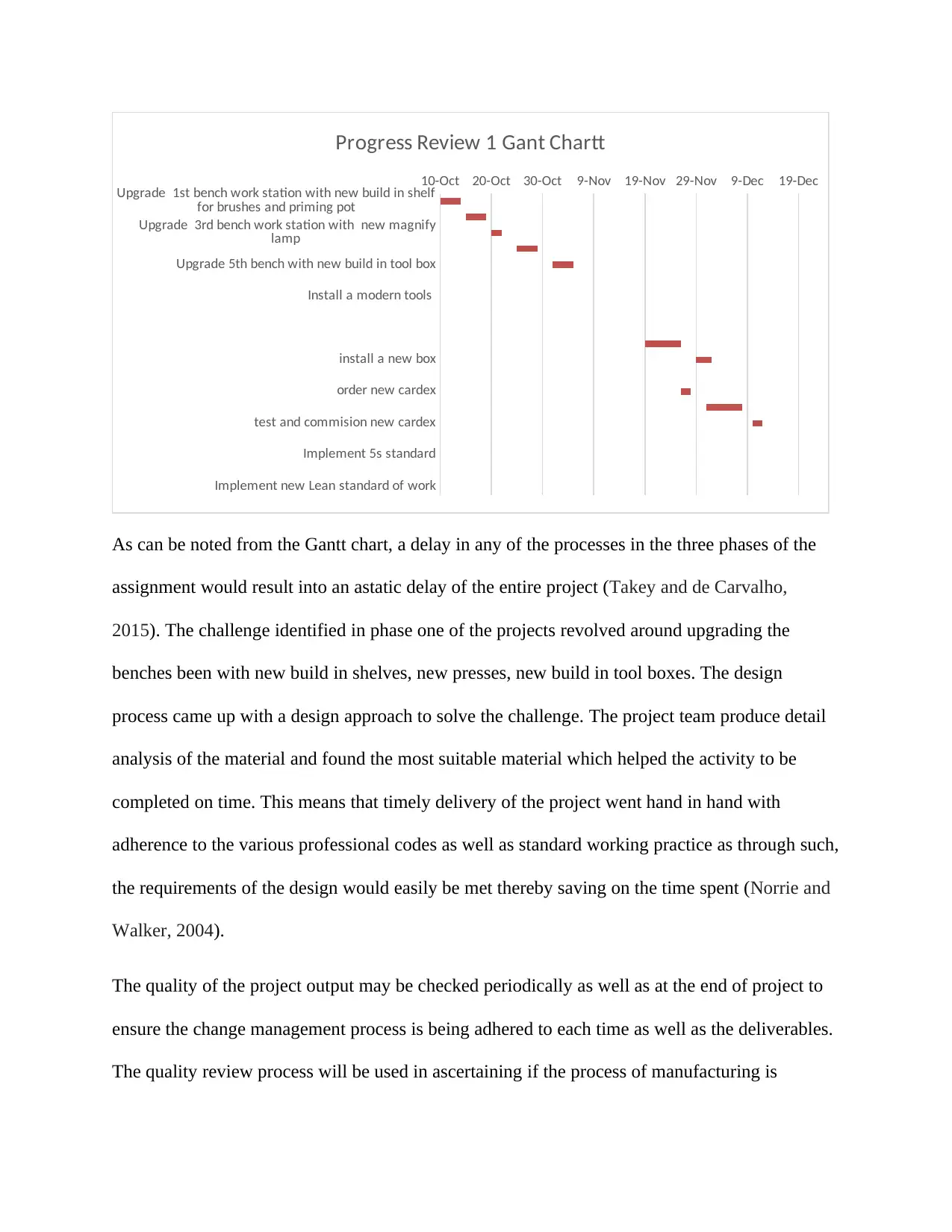
Upgrade 1st bench work station with new build in shelf
for brushes and priming pot
Upgrade 3rd bench work station with new magnify
lamp
Upgrade 5th bench with new build in tool box
Install a modern tools
install a new box
order new cardex
test and commision new cardex
Implement 5s standard
Implement new Lean standard of work
10-Oct 20-Oct 30-Oct 9-Nov 19-Nov 29-Nov 9-Dec 19-Dec
Progress Review 1 Gant Chartt
As can be noted from the Gantt chart, a delay in any of the processes in the three phases of the
assignment would result into an astatic delay of the entire project (Takey and de Carvalho,
2015). The challenge identified in phase one of the projects revolved around upgrading the
benches been with new build in shelves, new presses, new build in tool boxes. The design
process came up with a design approach to solve the challenge. The project team produce detail
analysis of the material and found the most suitable material which helped the activity to be
completed on time. This means that timely delivery of the project went hand in hand with
adherence to the various professional codes as well as standard working practice as through such,
the requirements of the design would easily be met thereby saving on the time spent (Norrie and
Walker, 2004).
The quality of the project output may be checked periodically as well as at the end of project to
ensure the change management process is being adhered to each time as well as the deliverables.
The quality review process will be used in ascertaining if the process of manufacturing is
for brushes and priming pot
Upgrade 3rd bench work station with new magnify
lamp
Upgrade 5th bench with new build in tool box
Install a modern tools
install a new box
order new cardex
test and commision new cardex
Implement 5s standard
Implement new Lean standard of work
10-Oct 20-Oct 30-Oct 9-Nov 19-Nov 29-Nov 9-Dec 19-Dec
Progress Review 1 Gant Chartt
As can be noted from the Gantt chart, a delay in any of the processes in the three phases of the
assignment would result into an astatic delay of the entire project (Takey and de Carvalho,
2015). The challenge identified in phase one of the projects revolved around upgrading the
benches been with new build in shelves, new presses, new build in tool boxes. The design
process came up with a design approach to solve the challenge. The project team produce detail
analysis of the material and found the most suitable material which helped the activity to be
completed on time. This means that timely delivery of the project went hand in hand with
adherence to the various professional codes as well as standard working practice as through such,
the requirements of the design would easily be met thereby saving on the time spent (Norrie and
Walker, 2004).
The quality of the project output may be checked periodically as well as at the end of project to
ensure the change management process is being adhered to each time as well as the deliverables.
The quality review process will be used in ascertaining if the process of manufacturing is
Secure Best Marks with AI Grader
Need help grading? Try our AI Grader for instant feedback on your assignments.

meeting the standards as outlined within the quality plans. By ensuring that the initial quality
plans are met, the products will be made within the constraints of the anticipated quality and this
would ensure reduction or elimination of possible wastages as a result of not manufacturing to
expectations. Professional standards, standard working conditions as well as standard process are
ideal in ensuring the quality of the products is attained as anticipated. With regard to professional
standards and standard processes reference should be made to the various codes of ethics for
engineers that would serve as a proof as to whether the activity being carried out is
recommended (Kerzner and Kerzner, 2017).
The professional standards are an integral part of the sustainability attainment aspects of the
project. While focus should be on ensuring that the required quality is attained of the product, it
should not be done at the expense of the environment and sustainability (Nonino et al., 2018).
This means that all the activities should be carried out in such a way that guarantees protection of
the environment as well as minimal disturbance to the ecosystem. This is more evident in phase
one of the project that involves upgrading of the benches. It is recommended that the materials
used for the bench and the shelves be derived from the surrounding to ensure that there is no
white elephant in the project.
The wider team which are the stakeholders play a fundamental role in getting a great portion of
the work done hence there will be need to ensure continuous checking with the stakeholders and
establish their feeling regarding the project as it progresses and in case of anything they feel may
be done differently. By ensuring the manufacturing process takes into consideration these issues,
the best results are attainable at the most cost effective ways (Jugdev and Müller, 2005)
There are various methods that are adopted in the processes of production of various products.
To attain the best and cheapest ways of manufacturing, the industry standards should be adhered
plans are met, the products will be made within the constraints of the anticipated quality and this
would ensure reduction or elimination of possible wastages as a result of not manufacturing to
expectations. Professional standards, standard working conditions as well as standard process are
ideal in ensuring the quality of the products is attained as anticipated. With regard to professional
standards and standard processes reference should be made to the various codes of ethics for
engineers that would serve as a proof as to whether the activity being carried out is
recommended (Kerzner and Kerzner, 2017).
The professional standards are an integral part of the sustainability attainment aspects of the
project. While focus should be on ensuring that the required quality is attained of the product, it
should not be done at the expense of the environment and sustainability (Nonino et al., 2018).
This means that all the activities should be carried out in such a way that guarantees protection of
the environment as well as minimal disturbance to the ecosystem. This is more evident in phase
one of the project that involves upgrading of the benches. It is recommended that the materials
used for the bench and the shelves be derived from the surrounding to ensure that there is no
white elephant in the project.
The wider team which are the stakeholders play a fundamental role in getting a great portion of
the work done hence there will be need to ensure continuous checking with the stakeholders and
establish their feeling regarding the project as it progresses and in case of anything they feel may
be done differently. By ensuring the manufacturing process takes into consideration these issues,
the best results are attainable at the most cost effective ways (Jugdev and Müller, 2005)
There are various methods that are adopted in the processes of production of various products.
To attain the best and cheapest ways of manufacturing, the industry standards should be adhered
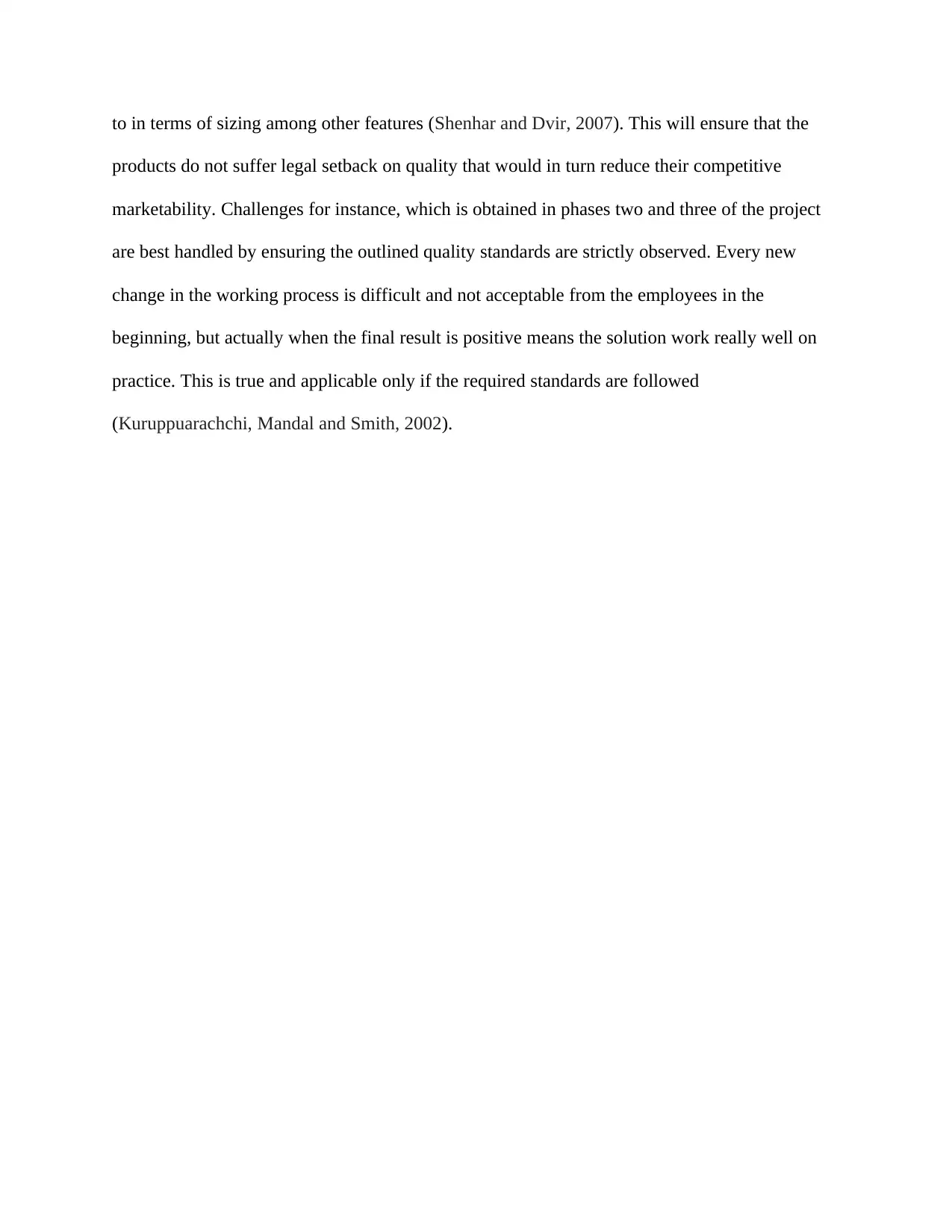
to in terms of sizing among other features (Shenhar and Dvir, 2007). This will ensure that the
products do not suffer legal setback on quality that would in turn reduce their competitive
marketability. Challenges for instance, which is obtained in phases two and three of the project
are best handled by ensuring the outlined quality standards are strictly observed. Every new
change in the working process is difficult and not acceptable from the employees in the
beginning, but actually when the final result is positive means the solution work really well on
practice. This is true and applicable only if the required standards are followed
(Kuruppuarachchi, Mandal and Smith, 2002).
products do not suffer legal setback on quality that would in turn reduce their competitive
marketability. Challenges for instance, which is obtained in phases two and three of the project
are best handled by ensuring the outlined quality standards are strictly observed. Every new
change in the working process is difficult and not acceptable from the employees in the
beginning, but actually when the final result is positive means the solution work really well on
practice. This is true and applicable only if the required standards are followed
(Kuruppuarachchi, Mandal and Smith, 2002).
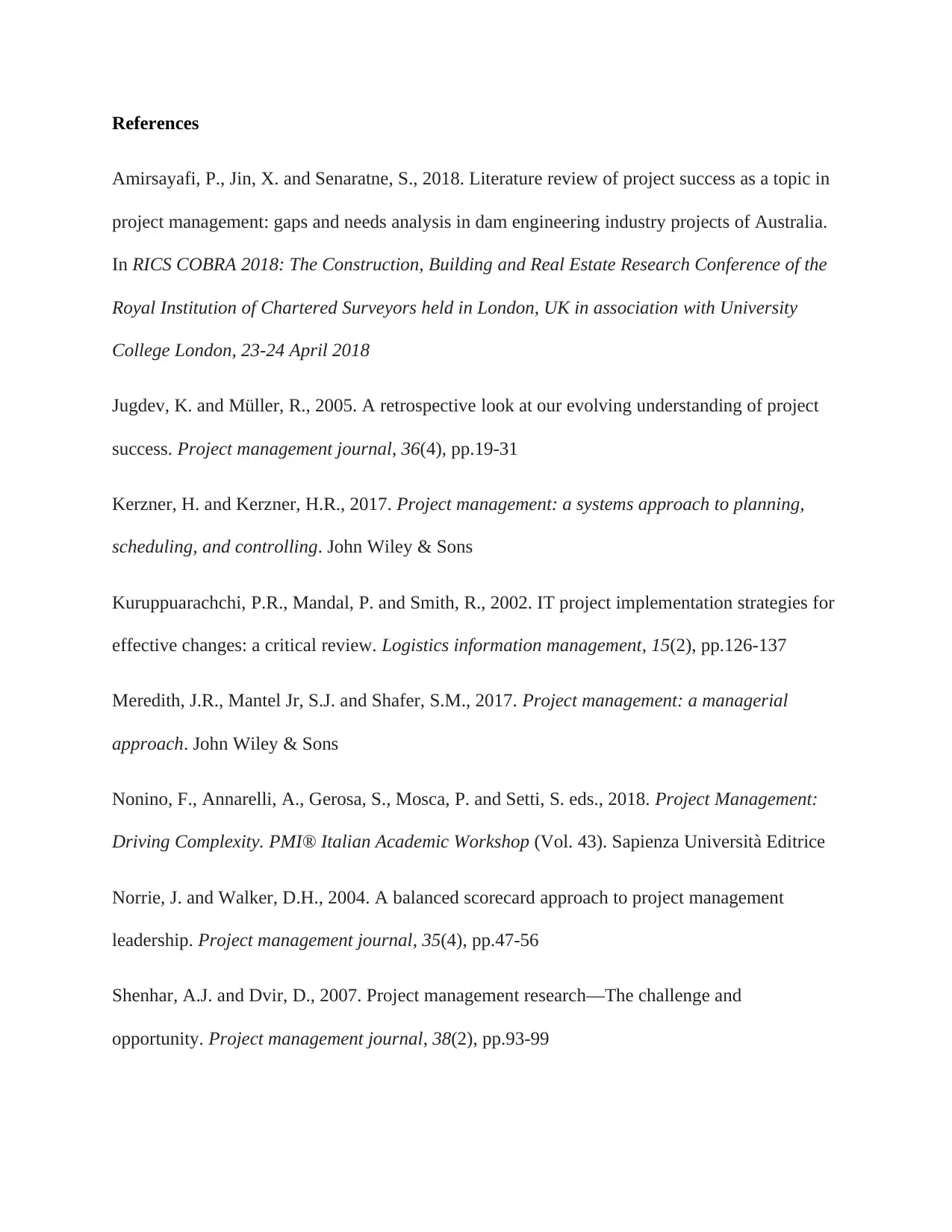
References
Amirsayafi, P., Jin, X. and Senaratne, S., 2018. Literature review of project success as a topic in
project management: gaps and needs analysis in dam engineering industry projects of Australia.
In RICS COBRA 2018: The Construction, Building and Real Estate Research Conference of the
Royal Institution of Chartered Surveyors held in London, UK in association with University
College London, 23-24 April 2018
Jugdev, K. and Müller, R., 2005. A retrospective look at our evolving understanding of project
success. Project management journal, 36(4), pp.19-31
Kerzner, H. and Kerzner, H.R., 2017. Project management: a systems approach to planning,
scheduling, and controlling. John Wiley & Sons
Kuruppuarachchi, P.R., Mandal, P. and Smith, R., 2002. IT project implementation strategies for
effective changes: a critical review. Logistics information management, 15(2), pp.126-137
Meredith, J.R., Mantel Jr, S.J. and Shafer, S.M., 2017. Project management: a managerial
approach. John Wiley & Sons
Nonino, F., Annarelli, A., Gerosa, S., Mosca, P. and Setti, S. eds., 2018. Project Management:
Driving Complexity. PMI® Italian Academic Workshop (Vol. 43). Sapienza Università Editrice
Norrie, J. and Walker, D.H., 2004. A balanced scorecard approach to project management
leadership. Project management journal, 35(4), pp.47-56
Shenhar, A.J. and Dvir, D., 2007. Project management research—The challenge and
opportunity. Project management journal, 38(2), pp.93-99
Amirsayafi, P., Jin, X. and Senaratne, S., 2018. Literature review of project success as a topic in
project management: gaps and needs analysis in dam engineering industry projects of Australia.
In RICS COBRA 2018: The Construction, Building and Real Estate Research Conference of the
Royal Institution of Chartered Surveyors held in London, UK in association with University
College London, 23-24 April 2018
Jugdev, K. and Müller, R., 2005. A retrospective look at our evolving understanding of project
success. Project management journal, 36(4), pp.19-31
Kerzner, H. and Kerzner, H.R., 2017. Project management: a systems approach to planning,
scheduling, and controlling. John Wiley & Sons
Kuruppuarachchi, P.R., Mandal, P. and Smith, R., 2002. IT project implementation strategies for
effective changes: a critical review. Logistics information management, 15(2), pp.126-137
Meredith, J.R., Mantel Jr, S.J. and Shafer, S.M., 2017. Project management: a managerial
approach. John Wiley & Sons
Nonino, F., Annarelli, A., Gerosa, S., Mosca, P. and Setti, S. eds., 2018. Project Management:
Driving Complexity. PMI® Italian Academic Workshop (Vol. 43). Sapienza Università Editrice
Norrie, J. and Walker, D.H., 2004. A balanced scorecard approach to project management
leadership. Project management journal, 35(4), pp.47-56
Shenhar, A.J. and Dvir, D., 2007. Project management research—The challenge and
opportunity. Project management journal, 38(2), pp.93-99
Paraphrase This Document
Need a fresh take? Get an instant paraphrase of this document with our AI Paraphraser
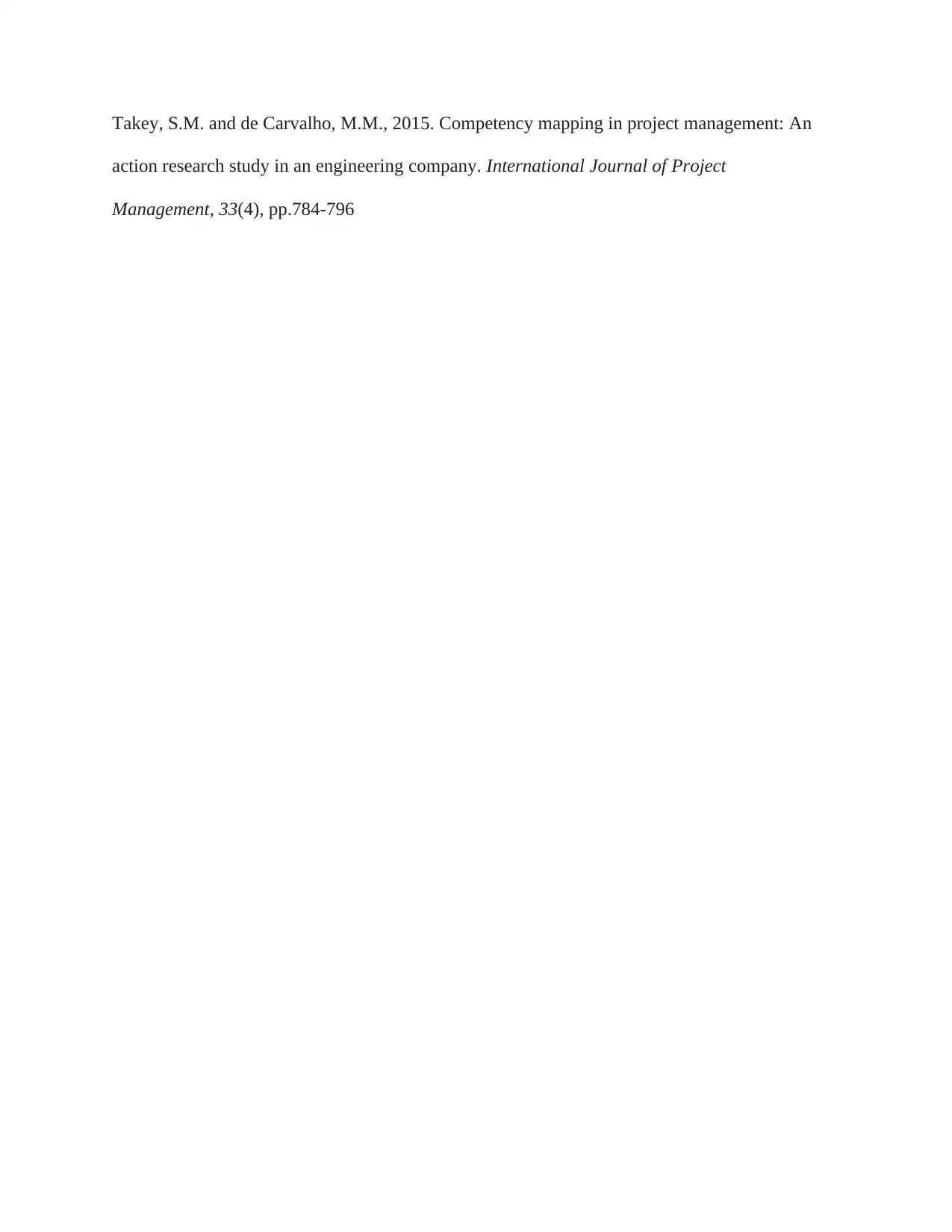
Takey, S.M. and de Carvalho, M.M., 2015. Competency mapping in project management: An
action research study in an engineering company. International Journal of Project
Management, 33(4), pp.784-796
action research study in an engineering company. International Journal of Project
Management, 33(4), pp.784-796
1 out of 8
Your All-in-One AI-Powered Toolkit for Academic Success.
+13062052269
info@desklib.com
Available 24*7 on WhatsApp / Email
![[object Object]](/_next/static/media/star-bottom.7253800d.svg)
Unlock your academic potential
© 2024 | Zucol Services PVT LTD | All rights reserved.